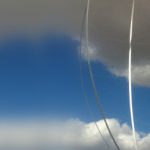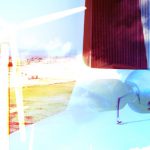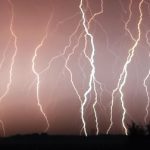In wind farm project design, the principle objective is to attain the lowest levelized cost of energy (LCOE). Several key variables contribute to this goal such as selecting the optimal wind turbine generator (WTG) for the site, positioning the WTGs to maximize production given available land, minimizing electrical losses, and designing the most cost-effective Balance of Plant (BOP). But one variable that can lower the levelized cost of energy is often overlooked: the collection system voltage.
The most commonly used collection system voltage for North American wind farms is 34.5kV. While this voltage has become the “standard” in the industry, it is not necessarily the best option for wind farms that are considering wind turbines that produce electricity at a medium voltage. Choosing the right wind turbine and optimizing the collection system design in conjunction with that wind turbine voltage could make the difference between a profitable project and an unprofitable project.
Acciona has extensive experience designing and building 12kV collection systems on the wind projects that it owns and operates worldwide, which is possible due to the unique 12kV electrical voltage of the wind turbine generator associated with the Acciona Windpower technology. Based on this experience and history, the benefits of a 12kV collection system are further described.
History of the 12kV System
Fifteen years ago, after establishing itself as an early leader in the development and ownership of utility scale wind farms in Spain, Acciona began designing and producing an in-house WTG technology to supply both its own and third-parties’ projects. Because Acciona’s WTG was engineered from the unique perspective of an owner/operator with vast experience owning and maintaining fleets of turbines from various other manufacturers, the design integrated several key improvements on what was, and is, available in the market. One key aspect of this design, and one that remains unique in the global WTG market to this day, is a generator voltage of 12kV. Table 1
Having experience with small hydroelectric power plants with 12kV generation that had operated successfully in some cases for over 50 years, Acciona decided the same proven technology could be applied to wind turbines. The principle motivator was to reduce LCOE. For many projects globally, a 12kV collection system that can avoid intermediate step-up transformers at the wind turbine is the best solution. Since the inception of the Acciona Windpower technology, the company’s turbines have been installed on 12kV collection systems at over 40 projects globally, yielding technical and financial benefits for numerous project owners. The rest of the projects have used traditional step-up transformers such as 20kV, 30kV, or 34.5kV in cases where those voltages were determined to be optimal.
Benefits of a 12kV System
The main benefit of using a 12 kV collection system (in conjunction with 12kV electrical generation from the WTG) is the reduction in BOP costs. The overall BOP cost of a 12kV collection system is usually lower than a 34.5kV system for at least two reasons. First, step-up transformers at the wind turbine (typically padmounted or in the WTG nacelle) would not be required since the electricity from the wind turbine is being directly injected into the collection system at 12kV. Second, 12kV collection system cable is less expensive per linear foot.
In addition to the above and also contributing significantly to the overall value of a 12kV system, the absence of step-up transformers allows for the realization of a stronger power curve (i.e. more energy production at a given wind speed) due to avoidance of electrical losses associated with the transformation of power from one voltage to another. This increase in energy production can be estimated between 1–1.5 percent, which is significant given that it occurs over the 20-plus year life of the wind farm. Figure 1 illustrates the comparison of a 12kV and 34.5kV collection system for a typical 61.5MW project, where the benefits are shown on a net present value (NPV) basis. In the example shown, the net NPV benefit of about $40,000/MW represents a savings of roughly $2.5 million, which can translate into $2–3/MWh lower LCOE. This is significant, especially for smaller-medium size projects where every dollar counts.
A 12kV collection system would also typically provide better reactive power capabilities than the traditional design, since WTG step-up transformers consume reactive power generated by the WTGs. In some cases, this reduction in reactive power performance would necessitate additional reactive power compensation in the substation, either through static means or, if dynamic features are necessary, with the installation of a STATCOM, increasing the BOP costs as well as the ongoing maintenance cost of the wind farm.
Cost savings on this system are also seen over the life of the project through reduced O&M costs. This includes savings due to avoided maintenance and replacement of WTG step-up transformers—maintenance that could also detract from the turbine availability. Wind farms leveraging this 12kV collection system will also see a dramatic reduction in the number of terminations and connections on the collection system. In instances where these critical terminations fail, there would be associated downtime until the issue is fixed.
How to Know if a 12kV System is Right for Your Project
A 12kV collection system (in conjunction with 12kV electrical generation from the WTG) can be the best choice for a number of different wind power project scenarios. However, it is typically the optimal solution for medium sized utility-scale projects where the furthest WTG is within three miles (five km) from the substation. If a project is smaller than 75MW, there is a high likelihood that the project’s economics can be improved by using a 12kV collection system. According to data produced by the American Wind Energy Association (AWEA), over the past five years approximately 35 percent of utility-scale wind farms installed in the U.S. are smaller than 75MW, yet the vast majority of these are utilizing 34.5kV collection systems (in conjunction with wind turbines that generate at 690V). This may have been the optimal solution with regard to other wind turbines, but if these projects would have installed a medium voltage wind turbine such as the 12kV Acciona Windpower technology, perhaps millions of dollars could have been saved through a more optimized design.
A wind farm is designed to maximize energy output with the lowest cost possible. However, there is typically a trade-off between the WTG layout that would maximize energy output and the layout that would minimize the MW installed cost. This is typically affected by the location of the designated interconnection point for the wind farm, which in most cases determines the location for the wind farm substation. Other factors can also affect the wind farm design such as constraints related to the complexity of the wind farm terrain, environmental or archaeological restrictions, proximity to cities or villages, and landowners and related permits.
All of these topics should be considered during the earliest stages of development for any wind farm project since these decisions can have a significant impact on the benefits that can be extracted from a 12kV collection system.
As previously described, there is a fairly quick rule of thumb to determine whether a 12kV collection system would be more economical than a higher voltage alternative. It is based on measuring the distance from the farthest WTG to the wind farm substation. Simply draw a circumference with a radius of three miles (five5 kilometers) around the substation, and check if more the 95 percent of WTGs are within that boundary. If that’s the case, the 12kV collection system option will typically be the optimal solution. For those cases that do not meet this criterion, one should still perform an analysis since cases have been known where 12kV is still the best option when this distance is around six or seven kilometers. This criterion is valid for any size wind turbine (e.g. 1.5MW or 3MW).
Real Examples of 12kV Systems
As previously mentioned, Acciona Windpower turbines have leveraged the 12kV collection system on over 40 projects globally, yielding technical and financial benefits for numerous project owners.
The best way to examine the benefits of a 12kV collection system is to explain real examples of wind farms where the technology has been installed and to analyze the overall NPV benefits. Three examples are presented below, where a complete economic and technical assessment was performed. The economic benefits are particularly sensitive to certain variables such as the energy price, cost for the electrical equipment, and the layout of the project, making the 12kV collection system option more or less compelling depending on each case. Therefore, it is recommended that each project is analyzed to determine the potential economic benefits of a 12kV collection system.
Yeong Yang (South Korea) – 49.5MW
This 49.5MW wind farm is located in South Korea and entered operation in 2009. There are 33, 1.5MW wind turbine generators operating at 60Hz frequency. All turbines are within the ideal range from the substation (i.e. less than five kilometers, or three miles).
Two different options were considered while designing this wind farm—12kV and 30kV. An optimal collection system design for each option was developed. The key variables considered were cable costs, trenching costs, substation switchgear costs, and WTG step-up transformer costs. For each case, the capitalization cost of electrical losses due to both cables and transformers over a 20-year time frame was considered. Electrical losses were also calculated based on the expected annual energy production of the wind farm.
To provide a basis for comparison between the two options, a baseline of 100 percent can be considered for the cost of the 12kV option, which includes cables, trenching and capitalization of losses. The cost of the 30kV option can then compared to this base level. In summary, the cable and trenching costs are lower for the 30kV option than the 12kV option; however, these costs are more than offset by the transformer capital costs and capitalization of electrical losses, resulting in a cost premium of 28 percent for the 30kV option. This economic assessment, combined with the technical benefits described above, provided the justification for a 12kV collection system at this site.
Lameque (Canada) – 45MW
This 45MW wind farm is located on the Atlantic coast in New Brunswick, Canada and entered operation in March, 2011. There are 30, 1.5MW units operating at 60Hz frequency. All turbines are within the ideal range from the substation (i.e. less than five kilometers, or three miles).
Following the same criteria as Yeong Yang, a study was completed comparing the advantages of the 12kV collection system over the 34.5kV collection system for the Lameque wind farm project. However, the case for a 12kV collection system is even more compelling in this case because the alternative option introduced a cost increment of 46 percent.
In contrast to the Yeong Yang project discussed above, the capitalized electrical losses for the 12kV collection system for this project were actually higher than those for the 34.5kV collection system. However, overall there was still a clear economic advantage for the 12kV model. Therefore, the cost of WTG step-up transformers and switchgear more than offset the higher electrical losses seen in the 12kV model. Furthermore, this case was corroborated for other voltage scenarios to ensure that the 12kV model was optimal.
Waubra (Australia) – 192MW
This 192MW wind farm is located in Australia and entered into operation in 2009. There are 128, 1.5MW units operating at 50Hz frequency. Due to the large number of machines, the approach was to divide the wind farm into several sections and route the power through five mini-substations. All of these mini-substations operate at 12kV and step-up to 66kV for overhead transmission to the 220kV interconnect substation. Therefore, unlike the other cases, the solution proposed here also includes transformers from 12–to 66kV with a rated power of 50MW each. The distance from the furthest turbine to its corresponding substation is less than five kilometers. Furthermore, this solution demonstrated that the 12kV collection system can be leveraged in unique environments to yield additional project value.
The cost assessment performed for the Waubra project showed that while the electrical losses are higher in the 12kV collection system, this is more than offset by the significant reduction in capital costs. Overall, the 12kV collection system provides NPV savings around 10 percent, highlighting that the 12kV collection system can add value in diverse environments.
Acciona 12kV Options
Acciona Windpower is the only wind turbine OEM that has designed turbines to generate at 12kV, but medium voltage wind turbines may become more common (other OEMs have announced future products that will use between 6–12kV voltage). The Acciona Windpower Product Line includes the AW1500, 1.5MW wind turbine generator using an 82-, 77-, or 70-meter rotor diameter and the AW3000, 3.0MW wind turbine generator using a 125-, 116-, 109-, or 100-meter rotor diameter. Acciona offers each of its wind turbine generator models at multiple tower heights with both concrete and steel options that vary by rotor diameter selected.
In addition to the 12kV collection system, Acciona Windpower’s global fleet of WTGs have recorded 98 percent availability and a failure rate of less than 1 percent on major components across its installed global fleet of more than 3,900MW in 13 countries.
Conclusion
When designing the layout of a wind farm and modeling its financial and technical performance, don’t assume that the “standard” 34.5kV collection system is the only or most economically sound option. In many cases it is not, especially when there is an opportunity to install a medium voltage wind turbine. Once a preliminary layout for the substation and the WTGs has been defined, an analysis regarding the optimal collection system voltage should be performed. This analysis takes a holistic approach, taking into consideration all economic aspects of the project such as cost of the wind turbines, electrical losses, transformer costs, and maintenance costs over the project’s 20-year life. A wind farm developed with either the AW1500 or AW3000 and with a layout where all WTGs are within a radius of five kilometers (about three miles) from the substation presents the opportunity to improve energy production and reduce the overall BOP cost by utilizing a 12kV collection system.
When this criterion is not possible to achieve, there is still potential to achieve significant savings using the 12kV collection system, as seen in the example of Waubra, highlighted above.








































